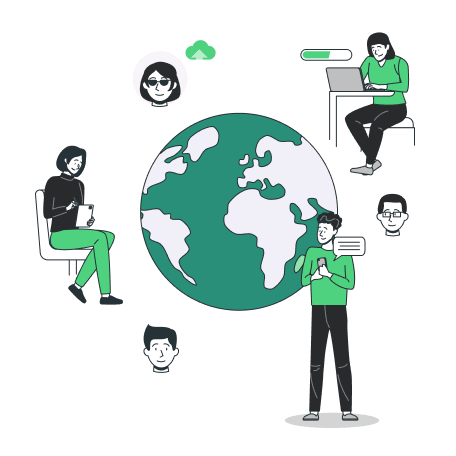How to Get Hired by Remote-First US Companies: A Guide for Global Talent
Introduction
Remote-first companies in the US — from fast-moving startups to nimble small businesses — are hiring beyond borders. The demand for skilled professionals in emerging markets like India has never been higher. But being “remote-ready” is just the starting point. To land these roles, job seekers need to be intentional, visible, and aligned with how distributed teams operate.
Here’s how to strategically position yourself to win global opportunities.
Summary: Getting Hired by Remote-First US Companies
Definition: Remote-first startups and SMBs in the US are hiring beyond borders, with demand for skilled professionals in India and emerging markets at an all-time high.
Lesson: Technical skills get you noticed, but async collaboration, proactive communication, and digital presence determine who gets hired.
How to act:
- Build a clear, outcome-driven digital profile (LinkedIn, portfolio, GitHub).
- Show remote fluency: async updates, timezone handoffs, documentation.
- Engage in remote work communities to gain visibility and referrals.
Advantage: Candidates who demonstrate remote-readiness stand out and land roles faster with US startups and global-first companies.
What Remote-First Teams Are Really Looking For
Founders and hiring managers aren’t just evaluating technical expertise. They’re building lean, high-trust teams where each member:
- Operates independently
- Communicates proactively
- Makes decisions with limited supervision
- Aligns with the company’s mission and growth stage
Your application should highlight not just what you know, but how you work—async across time zones, navigating ambiguity, and staying aligned with team goals.
Make Your Digital Presence Work Overtime
Hiring managers often see your LinkedIn, GitHub, or portfolio before your resume. In under 10 seconds, they should understand:
- What you do
- The problems you solve
- Why you’d be a strong fit for a remote-first team
✅ Tips:
- Use a clear LinkedIn headline (e.g., Full-Stack Developer | SaaS Scaling | Remote-First Mindset).
- Showcase measurable achievements (growth %, cost saved, velocity improved).
- Link to projects, blogs, or side work.
- Engage thoughtfully in niche platforms.
Apply With the Remote Context in Mind
Generic resumes fall flat. Remote-first teams want to know: How do you work when no one is watching?
Instead of just listing tools, explain how you use them:
| Attribute | What to Highlight |
| Async Collaboration | Tools (Notion, Loom), update habits, timezone handoffs |
| Ownership | Independent projects, decision-making stories |
| Communication | Writing samples, meeting recaps, documentation |
| Team Integration | Onboarding global teammates, cross-border workflows |
Turn Time Zones Into a Strength
Instead of seeing time differences as a limitation, frame them as a productivity boost:
- “I ensure clean handoffs with US teammates via end-of-day updates.”
- “I use Loom and Notion for async sync.”
- “I keep 2–3 overlap hours for standups or reviews.”
This shifts timezone gaps into a strategic advantage.
Show Up Where Global Hiring Happens
Not all opportunities start on job boards. Remote-first companies often find talent in community spaces:
- Remote work Slack/Discord groups
- GitHub projects and open-source contributions
- Twitter/X spaces, AMAs, or niche newsletters
Visibility here often leads to referrals and contracts.
Communicate Like a Remote Teammate
Writing is the lifeblood of distributed teams. Stand out by:
- Writing updates that answer what, why, and next steps
- Summarizing meetings with clear takeaways
- Publishing short posts on LinkedIn/blogs to show thought clarity
Clarity → Trust → Opportunity.
Be Interview-Ready for Distributed Teams
Remote interviews test more than skills — they test if you can thrive without in-person guidance. Come prepared to:
- Share examples of overcoming remote challenges
- Ask about async processes
- Describe your onboarding expectations
- Show up with a quiet, well-lit, stable setup
Invest in Remote-First Skills
Beyond technical depth, learn the systems and tools of remote work:
- Tools: Notion, Miro, Loom, Slack workflows
- Systems: Async sprints, structured docs, time blocking
- Cross-functional basics: Product management, UX, growth metrics
This makes you remote-literate and more valuable to global employers.
You’re Not Just Another Remote Candidate
Remote work has expanded access to global opportunities — but also raised the bar. Success now requires self-drive, communication, and alignment with mission-driven companies.
At Ralent, we help US startups build remote teams in India by connecting them with startup-ready professionals who thrive in remote-first environments. If you want to join a high-impact, mission-driven company where your work scales globally, we can help.
👉 Explore how we enable global talent hiring and scaling GCCs in India.
🔗 Related Insights:
Related Resources
SEZ Indian Evolution in 2025–26: Growth Catalyst for Global Investors
Building High-Trust US–India Teams: Lessons from the Ground
Beyond Bengaluru: India’s Next GCC Cities (2025–2026)
Schedule a personalized 1:1
